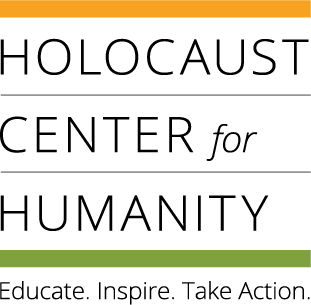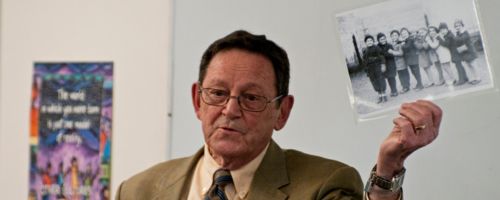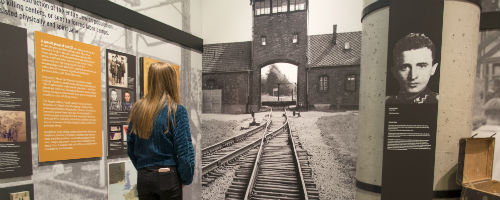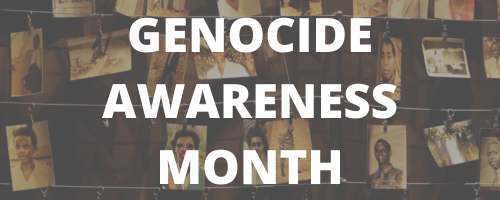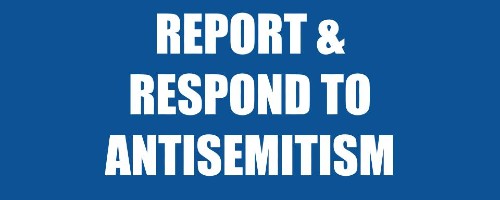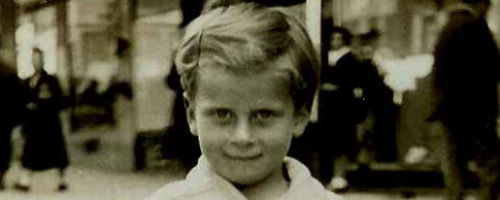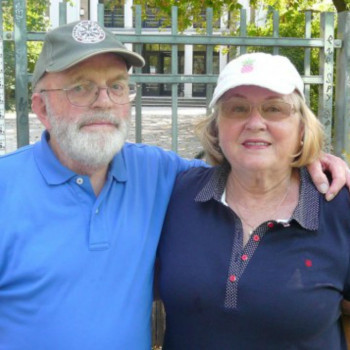
 Henry Haas was born to two Jewish families in Berlin Germany on April 8, 1938. In July, 1938, his parents Ivan Hans Haas (later John) and Gerda resolved to escape but had no way, literally, to immigrate to any country in the world. They fled for 12 months, traveling first to Slovakia, then the Czech Republic, Italy, Holland and France. Finally, in July 1939, with the assistance of a Jewish Refugee organization in Paris France, they were able to secure tickets on a ship to Shanghai, China. This was the only port in the world, which, from 1933 to 1941, admitted approximately 17,000 Jews. The Haas family ship journey took three weeks, traveling from Marseille, France to Port Said Egypt, through the Suez Canal to Djibouti on the horn of Africa, and eventually to the port of Shanghai. A city of 6 million at that time, the Haas family arrived in Shanghai without funds, in a temperature of 105 degrees Fahrenheit, and encountered an entirely foreign culture.
Henry Haas was born to two Jewish families in Berlin Germany on April 8, 1938. In July, 1938, his parents Ivan Hans Haas (later John) and Gerda resolved to escape but had no way, literally, to immigrate to any country in the world. They fled for 12 months, traveling first to Slovakia, then the Czech Republic, Italy, Holland and France. Finally, in July 1939, with the assistance of a Jewish Refugee organization in Paris France, they were able to secure tickets on a ship to Shanghai, China. This was the only port in the world, which, from 1933 to 1941, admitted approximately 17,000 Jews. The Haas family ship journey took three weeks, traveling from Marseille, France to Port Said Egypt, through the Suez Canal to Djibouti on the horn of Africa, and eventually to the port of Shanghai. A city of 6 million at that time, the Haas family arrived in Shanghai without funds, in a temperature of 105 degrees Fahrenheit, and encountered an entirely foreign culture.
The following eight years were spent under Japanese occupation, living in an area that became the “Ghetto of Hongkew”, with their home being a single small room – no bathroom, no toilet, and no kitchen.
In 1947, two years after the end of WWII, the family arrived as non-Englis h speaking refugees, in San Francisco. The Hebrew Immigrant Aid Society (HIAS), helped the Haas family to come to America. First they settled in Portland Oregon, then Centralia Washington, and, finally, in Tacoma Washington.
Kate, Henry ’s wife, born and brought up near London, England, came to Tacoma at age nineteen for a visit and stayed. Kate Haas has written the Haas family story in great detail. Together, Henry and Kate, with the use of photos, maps, and historic family documents, tell the story. Henry and his late mother Gerda, who live d to age 98, told this story for many years to school classes and other groups in the Tacoma area. Now, Henry has joined the speaker’s bureau to further share this memoir of anti-Semitism, during the Holocaust.
Henry graduated from the University of Puget Sound and obtained a law degree from the University of Washington in 1962. He continues practicing law to this day.
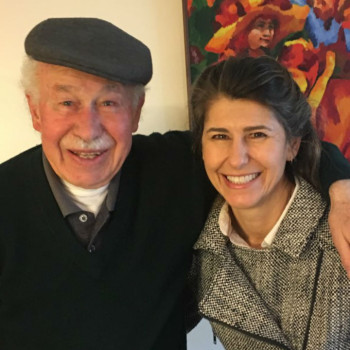
Daughter of Tom Lenda, a child survivor of Theresienstadt, Hana Kern shares her father's experiences.
 Tom Lenda was born Tomas Lustig in 1936 in Plzen, Czechoslovakia (now Czech Republic). Tom’s father, Pavel (Paul) Lustig, was born in Domazlice, Czechoslovakia in 1904. The Lustig family moved to Plzen shortly after Paul was born. Tom’s mother, Irene Spitz, was born in Austria in 1909. Her family later moved to Decin, a city north of Prague.
Tom Lenda was born Tomas Lustig in 1936 in Plzen, Czechoslovakia (now Czech Republic). Tom’s father, Pavel (Paul) Lustig, was born in Domazlice, Czechoslovakia in 1904. The Lustig family moved to Plzen shortly after Paul was born. Tom’s mother, Irene Spitz, was born in Austria in 1909. Her family later moved to Decin, a city north of Prague.
The Lustig family was warm, loving, and hard working. Tom’s father Paul was educated in commerce and also attended a textile college in England. He was fluent in several languages and was an established textile manufacturers’ representative when Tom was born. Tom’s mother worked as a certified nurse in a hospital until her marriage. The Lustig family was part of a close-knit clan that was well established within the Czech community; they considered themselves proud Czechoslovak citizens of the Jewish religion.
The Nazi invasion of Czechoslovakia became a reality for the Lustig family on March 15, 1939. Little Tommy was almost three years old. Three years later, the family was sent to Terezin (Theresienstadt), a concentration camp 40 miles north of Prague.
The Lustig family was separated after their arrival at Terezin. Tom was placed in a heim (home) with other children. Irene started work as a nurse in the camp hospital, also her living quarters. Paul was assigned to a transportleitung (transportation) group and was deported to Auschwitz in fall 1944. Toward the end of the war, when the Soviet Army approached the camp, Paul escaped from Auschwitz with a small group and joined the Czechoslovak army. After liberation, Paul came back to Terezin to retrieve his family on May 25th, 1945, and the three were reunited.
Hana was born to Rose and Tom Lenda in 1966 in Czechoslovakia. The Lendas escaped from communist Czechoslovakia to Germany in 1968 and then moved to Australia before arriving in the United States in 1975. Tom's book, Children on Death Row, was published under his birth name, Tommy Lustig.
Today, Hana is an attorney in Seattle and has two children. For years, Hana helped her father with his presentations in schools. She is proud to carry on her father’s story , and officially became a member of the Speakers Bureau in 2019.
Photo: Tom Lenda with his daughter, Hana Kern, 2019.
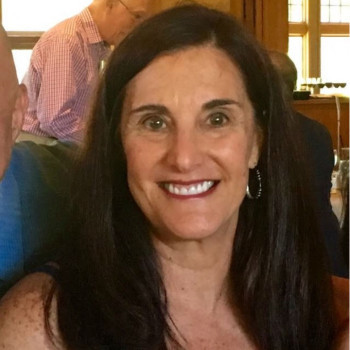
 Randee Kissinger's mother was a cousin of Vera Frank Federman's husband. Vera was born June 27, 1924. She grew up in Debrecen, Hungary as an only child, but with a large extended family. She studied both English and German and graduated from a girls’ high school.
Randee Kissinger's mother was a cousin of Vera Frank Federman's husband. Vera was born June 27, 1924. She grew up in Debrecen, Hungary as an only child, but with a large extended family. She studied both English and German and graduated from a girls’ high school.
On March 19, 1944 the Nazis occupied Hungary and soon thereafter deprived Jews of their civil rights. The Nazis, assisted by the Hungarian Arrow Cross, forced Jews out of their homes, businesses, and schools and into ghettos. Vera and her family, including her best friend and cousin, Marika Frank, were rounded up into the Debrecen ghetto along with the remaining Jewish population of their town. After several months in the ghetto and doing forced labor in a brick factory, they boarded cattle cars to Auschwitz Concentration Camp. It was June 27th 1944, Vera’s 20th birthday.
Vera was in Auschwitz for six weeks before the Nazis sent her to a munitions factory in Allendorf, a sub camp of Buchenwald, where she was a slave laborer. American forces liberated her there on March 28th, 1945. When Vera spoke later about this factory, she said that whenever they could, she and her friends did not fill the bullets with gun powder.
Vera was the only surviving member of her immediate family. After the war, she came to Seattle on a scholarship from the Hillel Foundation to attend the University of Washington. She married Marvin Federman and had two children.
Vera was a member of the Holocaust Center’s Speakers Bureau for many years. Vera passed away in 2017.
As a relative of Vera’s husband, Randee was always interested in Vera’s story . After Vera passed away, Randee decided that she wanted to tell her cousin’s story to students in the Pacific Northwest. Utilizing two testimonies by Vera at the Holocaust Center, Randee and the Center worked to develop a presentation using Vera’s video clips. Randee is currently a teacher at Maywood Middle School in Renton, WA where she teaches the Holocaust. She became a member of the Speakers Bureau in 2018.
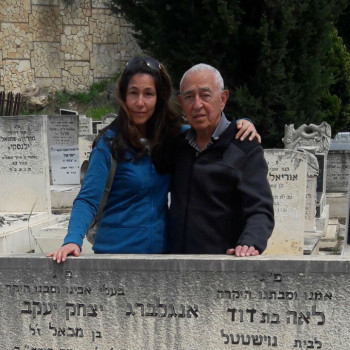
 Michal’s father, Arieh Engelberg, was born in Tanobrezg, Poland in 1934. “I am the daughter of a Holocaust survivor. There are many and different Holocaust survivor stories. My family was expelled from their home town of Tarnobrezg, Poland where they had resided for generations. My family was expelled for one reason only – because they were Jewish. They were not alone. Thousands of Jews were expelled from Polish towns – where did they go? How did they know to go there? How did they survive? This is the story of my family.”
Michal’s father, Arieh Engelberg, was born in Tanobrezg, Poland in 1934. “I am the daughter of a Holocaust survivor. There are many and different Holocaust survivor stories. My family was expelled from their home town of Tarnobrezg, Poland where they had resided for generations. My family was expelled for one reason only – because they were Jewish. They were not alone. Thousands of Jews were expelled from Polish towns – where did they go? How did they know to go there? How did they survive? This is the story of my family.”
In 1939, when Arieh was only 5 years old, Germany invaded Poland. As part of the Molotov-Ribbentrop Pact, dividing Poland between Germany and the Soviet Union, Polish Jews living close to the dividing line with the Soviet Union in Poland were forced to leave their homes.
Arieh’s family decided that it would be safest to move east into the Soviet Union with the hope that they would be able to return to their home soon. Instead, they became part of a migrant group sent to various labor camps as far away as Siberia. When the war ended, they were loaded onto railcars and sent back to Poland. They applied for visas to Israel, which were granted in 1950.
The Engelberg family traveled over 12,000 miles between 1939 and 1950 escaping the Holocaust.
In Israel, Arieh served in the Israeli Defense Forces and became a mechanical engineer. He married Michal’s mother, Sarah, in 1964. In 1975 Arieh moved to Vancouver, BC, accepting a job as an off-shore and sub-sea engineer. In 1976 his wife and family joined him.
“My father’s family was propelled into a life they didn’t wish for and had no control over. With the help of the Holocaust Center for Humanity, my father’s oral and written testimonies and his school certificates, I was able to trace my family throughout the war. My father’s school certificates became important historical documents to unravel my family’s route as dictated by the communist regime.”
With primary sources, maps, and her father’s video testimony, Michal brings life to her family history.
